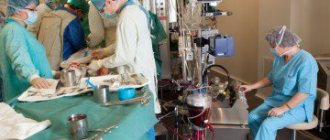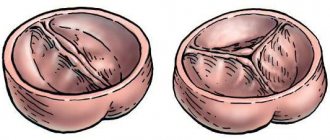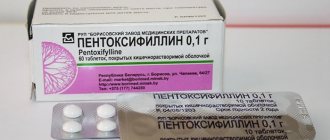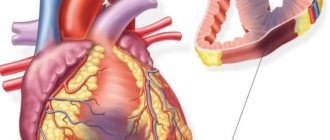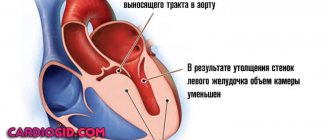When metabolic processes in the heart muscle are disrupted, the production of energy compounds decreases and toxic substances accumulate. This leads to the development of myocardial dystrophy. It is accompanied by pain in the heart, tachycardia and arrhythmia, fatigue, and shortness of breath. For treatment, drugs are used that improve myocardial nutrition, normalize rhythm and blood circulation.
Causes of the disease
Degenerative processes in the myocardium can be caused by a person’s lifestyle or pathologies from a fairly large list of various primary diseases, against the background of which heart failure will be a secondary pathology.
To summarize, we can state that a violation or change in the trophism of the cardiac muscle entails its restructuring. The table shows the main risk factors, and more information is presented in the video posted in this article.
| Cause | A comment |
| Toxic elements that negatively affect the heart muscles include radiation, poisons, drugs, ethyl alcohol, large doses of synthetic drugs and other dangerous substances. |
| Changes in hormonal levels are the cause of the development of dishormonal myocardial dystrophy. This is facilitated by dysfunction of the adrenal glands, thyroid and pancreas. The accumulation of lipid components in cytoplasmic cell membranes leads to antiphospholipid syndrome, which also provokes the formation of cardiac dystrophy. |
| Obesity or sudden weight loss leads to heart disease. |
| Abnormal physical manifestations disrupt the structure of the heart muscle: weightlessness, frequent and prolonged vibrations, injuries. |
| Viruses can damage the integrity of cardiac structures. Dangerous are: streptococcus (tonsillitis), treponema pallidum (syphilis) and HIV infection |
| All types of hepatitis, chronic liver diseases and severe forms of gastritis negatively affect the functioning of the heart. |
| The development of heart failure and the appearance of dystrophic transformations are caused by illnesses that cause pathological accumulations of substances in the cytoplasm of cells. For example, Wilson-Konovalov disease (copper ions accumulate), Glycogenosis (excessive glycogen deposits in hepatocytes) and other diseases. |
| Impaired renal filtration activity is the cause of heart disease. The most common causes of the disease are kidney cancer and glomerulonephritis. |
| In principle, any serious illness negatively affects the functioning of the heart muscles. In addition, it is important to note the negative impact of severe or prolonged stress, excessive regular physical activity, especially in strength sports, and a reduced level of hemoglobin in the blood. |
Note. Myocardial degeneration is not a primary disease. It always occurs as a result of the development of one or another pathology, the action of toxins or intense physical activity of a prolonged nature.
Diagnostics
Ultrasound of the heart
Since myocardial degeneration develops as a result of pathology, diagnostic procedures should always be comprehensive. The doctor listens to the patient’s complaints, studies the clinical picture, and conducts auscultation of the heart.
It is important in a conversation with a doctor to talk about the presence of chronic diseases; there may have been acute severe illnesses. The cardiologist must know the patient’s lifestyle and the presence of bad habits.
To determine cardiac pathology, the following tests are prescribed:
- A general blood test in case of cardiac pathology shows signs of anemia (a decrease in the number of red blood cells and hemoglobin concentration), a biochemical blood test is prescribed according to indications;
- Ultrasound of the heart, thyroid and pancreas , as well as the adrenal glands will help identify changes in the myocardium and endocrine pathologies;
- An ECG can detect changes in heart rhythm;
- Myocardial biopsy is a rather dangerous procedure, therefore it is carried out in extreme cases; histological analysis of tissue allows us to most accurately determine the pathology and understand all processes at the cellular level.
Important. In dystrophic processes, a biochemical blood test does not detect substances indicating tissue necrosis; this is detected during myocardial infarction.
Diagnostics
Myocardial dystrophy is diagnosed by a cardiologist. It is important to see a qualified specialist, since the first stage of the disease is sometimes asymptomatic.
At the first stage of diagnosis, the doctor must interview the patient, find out complaints, and collect anamnesis. To further check heart health, the patient should undergo the following examinations:
- electrocardiography;
- EchoCG;
- phonocardiography;
- X-ray of the heart;
- in difficult cases, an MRI is prescribed
All these methods will help you see an accurate picture of the course of the disease and its cause.
Clinical manifestations
The initial stages of the disease occur in a latent form. The clinical picture begins to appear when a person already has pathologies and heart failure develops.
The first signs should be the appearance of shortness of breath, lack of air during physical activity and rapid fatigue. Although these symptoms do not always alarm patients, and the cost of lost time is irreparably high.
Following these manifestations, over time the symptoms become more clear. The heart begins to ache, patients note the constant aching nature of the sensations that appear.
As a rule, the discomfort is intermittent at first. Then the person himself, without analyzing instruments, begins to feel a disturbance in the heartbeat, tachycardia develops, and the lower extremities begin to swell.
Acute myocardial dystrophy during sports activities
Strength exercises during long periods of exercise and heavy loads cause rapid wear and tear of the heart muscles
Excessive exercise over a long period of time depletes the heart. During training, it works harder and wears out faster (pulse up to 200 beats per minute, the myocardium does not have time to rest, there is no diastole).
The myocardium and other muscles feel a lack of energy; the cells are poisonously affected by excess lactic acid, which accumulates due to insufficient gas exchange in the cells. As a result, the muscles begin to be partially replaced by connective tissue, which prevents the heart from functioning fully.
During competitions, significant training, or non-compliance with a sports regime, a person may experience a crisis due to the inability of the heart to withstand the increased load.
Symptoms will be as follows:
- shortness of breath;
- dizziness;
- increased heart rate;
- muscle pain;
- nausea and vomiting;
- in especially severe cases, loss of consciousness or the onset of a borderline state is possible.
Such symptoms cannot go unnoticed by doctors. The athlete must stop training and be at rest, as otherwise there may be a threat to life. After a comprehensive examination, the doctor makes a decision on acceptable sports activities.
Note. The symptoms of a heart attack differ from a crisis during myocardial degeneration in that the pressure decreases, acute pain occurs in the heart area, and the patient may cough.
Symptoms
If the disease was not diagnosed at a young age, then most likely it proceeded without symptoms, which is why the patient did not consult a doctor. But basically, the disease does not go away without expressing signs. The main symptoms of myocardial dystrophy include:
- angina pectoris;
- increased blood pressure;
- feeling of lack of air;
- constant feeling of fear and insecurity;
- heart rhythm disturbance. It is observed very often with focal dystrophy;
- swelling of the lower extremities;
- decreased ability to work;
- high fatigue;
- sleep disturbance;
- increased level of sweating;
- weight loss;
- irritability of the patient;
- shortness of breath at rest;
- spreading pain over the entire left side of the body.
Classification
Alcoholic cardiomyopathy
Degenerative changes in the myocardium have several varieties, depending on the specifics of the disease and its location.
Types of cardiac dystrophy:
- Myocardial dystrophy in athletes. The causes and symptoms are described in the previous section;
- Focal (ischemic) dystrophy occurs due to the cessation of blood circulation in full through important arteries. It is often asymptomatic, but can cause pre-infarction conditions that are painless. This form is considered a borderline state between a heart attack and tachycardia;
- Dishormonal. The reason for the development is hormonal changes as a result of endocrine or diseases of the reproductive system;
- Tonsillogenic myocardial degeneration occurs as a result of the presence of streptococcal infection, the source of which is inflamed tonsils. In this case, the protein of the heart valves is similar to the protein of bacteria, so they are attacked by immune cells;
- Senile myocardial degeneration – age-related anatomical changes in the heart muscle;
- Alcoholic dystrophy or bull's heart is characteristic of persons suffering from alcoholism. The disease is manifested by shortness of breath and cardiac rhythm disturbances;
- Diffuse dystrophy is the presence of inflammation for various reasons.
General concepts
The disease myocardial dystrophy is a lesion of the heart muscle that appears as a result of metabolic disorders in it. This disorder of metabolic processes (metabolism) leads to damage to the structure and disruption of muscle cells, since it spreads to its entire surface. As a result, the contractility of the heart is significantly reduced.
The second name of the disease is myocardial dystrophy (the same heart muscle). Due to the fact that degeneration of cells - myocytes - and structures of the conduction system appears, the functions performed by the myocardium are disrupted. In addition to contractility, this includes excitability, conductivity, and automaticity. Basically, the disease is characterized as secondary, that is, arising as a result of some kind of disorder. The disease requires not only treatment, but also careful attention to the body for preventive purposes. It should be realized that such a disease cannot stop by relieving inflammation, since the disease is non-inflammatory in nature, and if the solution is treated superficially, it can even lead to disability.
structure of the heart lining and muscle layer
Treatment
Therapy for myocardial degeneration primarily consists of identifying the true cause and eliminating it. Only in the most severe cases is the patient hospitalized. Basically, a person is treated on an outpatient basis, periodically visiting a cardiologist and other specialized doctors.
Therapy involves:
- limiting physical activity or reducing activity;
- the patient is prescribed a nutritious diet containing proteins and carbohydrates; the body must receive all the necessary substances;
- eliminate bad habits;
- adjust hormonal levels;
- prescribe symptomatic drug treatment, for example, for anemia - iron supplements, for a lack of vitamins, vitamin-mineral complexes are prescribed, to nourish the heart muscles - mildronate, retabolil and others, for arrhythmia - calcium channel blockers, and so on;
- treatment of chronic diseases: for tonsillitis, tonsillectomy is indicated; for thyroid diseases, the causes are eliminated, treatment is prescribed, partial or complete resection is possible; for diabetes, a diet and insulin injections are prescribed.
In each specific case, treatment will be selected strictly individually, depending on the primary pathology. It is important for the patient to follow the doctor’s instructions and fully adhere to the prescribed treatment and lifestyle. In this case, the condition will improve and the exacerbation will subside.
Preventive measures
Degeneration of cardiac muscle tissue is a pathology that requires preventive measures. In order for the myocardium to perform its functions, it needs to receive a sufficient amount of oxygen and nutrients.
Main preventive measures:
- walking in the fresh air every day for at least 1 hour;
- proper nutrition, taking into account the calorie content of food;
- eating dried fruits, fatty fish, fish oil;
- drinking at least 1.5 liters of clean water without gas per day;
- ban on alcohol, drugs and smoking;
- medical examinations at least 1-2 times a year
- taking vitamin complexes.
If you follow all the above recommendations, your heart will remain healthy for many years.
Dystrophic changes in the myocardium on the ECG are the first sign of the development of many cardiovascular pathologies. Timely diagnosis and treatment is the only correct way out in this situation.
Forecast
Depending on the nature of the pathology, myocardial degeneration may or may not be curable. If the primary disease can be eliminated, then complete or partial recovery is possible. Usually nothing threatens life, but if the disease progresses to acute heart failure, then the person may die in the coming years.
Violating doctors' recommendations can also cause death. Athletes often die by ignoring acceptable standards during competitions or training.
Toxic and dishormonal myocardial dystrophy are most treatable; diseases associated with genetic pathologies are much more difficult to treat. For alcoholics (provided they completely stop drinking ethanol), it will take quite a long time before the heart begins to recover.
Prevention
Get regular examinations for early diagnosis of heart pathologies
Preventing a disease is much easier than treating it. Doctors recommend not to overwork yourself in sports, especially for amateur activities, where there is no constant supervision from doctors. If a person is exposed to stress for a long time, then an ECG should be done.
Treat endocrine diseases in a timely manner; in case of frequent sore throats and chronic tonsillitis, it is better to completely remove the tonsils. Do not prescribe medications on your own, carefully monitor the general condition of your body and lead a healthy lifestyle.

